Our biologist examines peak rut dates across the country.
Peak rut represents an annual high point for deer hunters and the bucks they pursue. It's not surprising that predicting when it will occur is the hottest topic in whitetail hunting.
Theories abound, based on a host of factors including temperature, barometric pressure, wind speed, type and amount of precipitation, moon phase, the earth's gravitational pull and the brown and white bands on a wooly bear caterpillar.
The fact is, predicting when the peak of rut will occur is not difficult, and there's no secret formula.
Whitetail breeding is based on photoperiodism — changes in the amount of daylight. Because fall daylight diminishes at the same rate and time every year, the rut happens at the same time, with very little exception. That’s no casual affirmation. It’s based on years of research from every state and province where whitetails live.
If you want to know when the peak of the rut occurs, you don’t need meteorological charts or crystal balls. Call your state biologist, or read on. We’ve done it for you.
We contacted biologists from every whitetail state and several provinces. Not all chose to respond, but you can fill in the blanks with a fair amount of certainty.
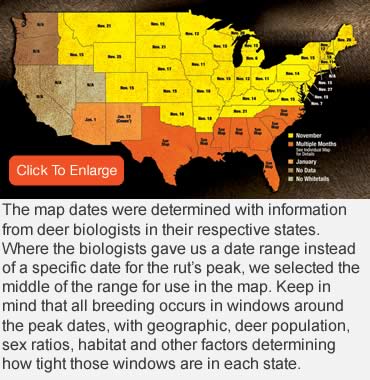 Before we continue, a little clarification is in order. One of our participants, Rod Cumberland from New Brunswick, stressed the distinction between peak rut and peak breeding. “I see these terms used interchangeably,” he said, “and hunters tend to lump it together as the rut. However, biologically and behaviorally, they are distinct times.”
Before we continue, a little clarification is in order. One of our participants, Rod Cumberland from New Brunswick, stressed the distinction between peak rut and peak breeding. “I see these terms used interchangeably,” he said, “and hunters tend to lump it together as the rut. However, biologically and behaviorally, they are distinct times.”
To a hunter, peak rut is the magical time when mature bucks drop their guard, sometimes wandering around in broad daylight in search of hot does, seemingly oblivious to the sight, sound and sometimes even the smell of humans. To a biologist, peak rut is peak breeding, a period when the majority of older bucks and receptive does have paired up and melted off to some secluded area, where they’ll remain until fulfilling their biological purpose in life.
The dates we’re discussing are the peak breeding dates. If you want to know how to exploit this information to predict the best hunting dates, you’ll have to wait for next month’s issue.
Here’s the only rut calendar you’ll ever need.
NORTHEAST
Lee Kantar from the Maine Department of Inland Fisheries and Wildlife noted that his predecessor, Gerry Lavigne, had done extensive work aging fetuses and calculating conception dates. From that, Lavigne calculated Maine’s peak rut between Nov. 17 and 23 for mature does, followed a week later by yearling does.
Kantar pointed out this represents the statistical high point, when the majority of does come into estrus, with a decreasing proportion earlier or later. He also said there isn’t much difference between Maine and New Brunswick.
Rod Cumberland, New Brunswick’s provincial deer biologist, has collected detailed information on peak rut times using fetal measurements. He observed a phenomenon where the rut shifts depending on deer herd status. “In the 1980s, when our deer densities were high, peak rut ran the last three weeks of November,” he explained. “When numbers get below 100,000, we seem to drop into a rut that runs the last two weeks of November and the first week of December.”
During the mid-2000s, New Brunswick attempted to grow their deer herd by dramatically reducing antlerless permits. “Once the sex and age ratios were a bit more balanced, the rut moved almost a week earlier,” he said. However, several severe winters have reduced deer densities, and the rut slipped back a week.
From his work with fetal measurements, former Vermont Deer Project Leader John Buck derived a range of conception dates between the fourth week in October and the second week in December. “The peak of conception occurred during the third week of November,” Buck said.
Massachusetts Division of Fisheries and Wildlife Deer and Moose Project Leader Sonja Christensen reports, “Our peak is around the latter half of the second week of November, right around Veteran’s Day.”
New Jersey Deer Project Leader Carole Kandoth said, “The peak of the rut for adult deer in northern New Jersey is Nov. 3 through 23. For fawns, it’s Nov. 17 through Dec. 7. The rut in the southern portion of the state lags by a few days.”
New York biologist Jeremy Hurst succinctly offered, “In New York, peak deer breeding occurs in mid-November.”
Things don’t change significantly as you move just down the coast a little. Delaware Game Mammal Biologist Joe Rogerson reports 80 percent of the does in Delaware will be bred from Nov. 10 through 20.
Based on 14 years of data, 90 percent of Pennsylvania does are bred between Oct. 16 and Dec. 16, with a mean conception date of Nov. 14.
Maryland Deer Project Leader Brian Eyler said Maryland’s peak rut is consistently from Nov. 1 through 15 with little to no variation across the state.
According to Virginia Deer Project Coordinator Matt Knox, peak breeding typically occurs after mid-November across most of the state and possibly earlier in the east. Conception data for Virginia indicate the majority of does are bred in a six- to eight-day period. Does not bred during their first estrus will come into estrus again about 28 days later.
Meanwhile, West Virginia Supervisor of Game Management Services Christopher Ryan reports a peak whitetail rut from Nov. 8 through 14, with some slight difference from north to south, although still within that range.
EAST-CENTRAL
Ohio Deer Project Leader Mike Tonkovich noted more than 70 percent of adult does in his state were bred Nov. 3 through 23, while doe fawns that were bred conceived a month later.
Deer Research Biologist Chad Stewart said the Indiana Department of Natural Resources does not specifically keep rut data, but suggested piecing together the Indiana puzzle with data from nearby states of Illinois, Ohio and Kentucky. He added, “A lot of rutting behavior occurs in early to mid-November, with Nov. 8 through 15 a pretty good time to encounter a rutting deer in Indiana.”
Citing figures provided by Big Game Biologist Tina Brunjes, Kentucky’s Lee McClellan said, “The rut typically occurs in Kentucky during the middle two weeks of November. This year, that would be roughly Nov. 7 through 28.” He qualified that by noting, “This may vary from three to seven days from west to east Kentucky, with the rut coming earlier in western Kentucky.
According to Big Game Program Coordinator Daryl Ratajczak, Tennessee’s average conception date varies slightly across the state’s four regions, peaking Nov. 21 in the west, Nov. 25 in the east and Nov. 17 in the two central regions.
UPPER MIDWEST
Michigan DNR Deer and Elk Program Leader Brent Rudolph said it has been some time since biologists there have done a concerted study, but he was happy to share the data. “The last time we pulled fetuses, the data was pretty consistent,” he said. “Mean conception date for lower Michigan was around Nov. 6. For the upper portion of the Lower Peninsula, it was Nov. 15, and Nov. 20 in the UP. There was more variation in the lower part of the state, where more fawns were bred. They generally conceived three or four weeks later.”
Minnesota didn’t respond to our query, but I was able to locate some Minnesota data showing the average peak breeding date from 1980 to 1987. In that span, 80 percent of adult does were bred between Oct. 29 and Nov. 26. Twenty-four percent were bred between Nov. 1 and Nov. 7, and peak breeding occurred during the week of Nov. 12.
THE HEARTLAND
Tom Micetich, deer project manager for the Illinois Deptartment of Natural Resources, reports, “Our range has been from Nov. 10 through 20 over the years. The 15th has been the average peak, plus or minus a few days will catch it for most years.”
Iowa biologist Tom Litchfield reports their peak breeding usually occurs Nov. 8 through 15, and is fairly consistent. Because the habitat is so good, a high percentage of Iowa doe fawns, more than 50 percent on average, also breed and usually come into estrus in early December.
Lonnie Hansen reports a slightly later peak in Missouri, with the median date of conception for adult does as Nov. 16. “This does not appear to vary much within the state,” he explains. “If fawns breed their first year, it is two to three weeks later than the adults.”
Kansas Big Game Program Coordinator Lloyd Fox cited mid-November as peak of the rut. “We have limited observations of fawning and breeding in Kansas, but those observations agree with larger studies, such as the one completed in Missouri,” he said. “The peak of fawn births occurs the first or second week in June, which agrees with conception in mid-November.” He also examined fetuses of does killed in January, February and March. Fetal measurements corresponded to a mid-November conception.
Arkansas Game and Fish Commission Deer Program Coordinator Brad Miller said, “Our statewide mean conception date is Nov. 18, with a standard deviation of 15 days.” Most of that deviation is because of regional differences.
Oklahoma biologists didn’t get back to us, but information on the Oklahoma Wildlife Department’s website indicates their rut peaks in the second week of November.
THE WEST
Only a couple western states responded to our survey, but their responses are probably representative of the region. Montana’s Jeff Herbert estimated peak rut generally encompasses the mid- to late November period, but cautioned that estimate was based largely on anecdotal information. “It may begin a bit earlier in the western portion of the state,” he said.
Colorado Division of Wildlife’s Randy Hampton questioned biologists from around his state, but only got a response from the southeast regional biologist who puts that region’s rut peak at Nov. 1 through 15.
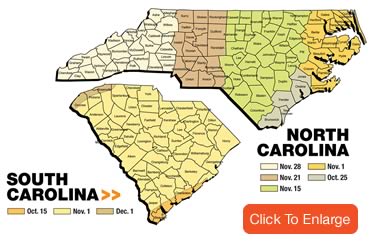 SOUTH ATLANTIC
SOUTH ATLANTIC
As we jump back to the East Coast and move south, rut dates make a dramatic turn.
North Carolina biologist Evin Stanford reports the statewide average peak rut is around Nov. 15, but it varies on a regional gradient: Lower Coastal Plain, Oct. 25; Upper Coast Plain, Nov. 1; Piedmont, Nov. 15; Foothills, Nov. 21; and Mountains, Nov. 28.
Using deer reproductive data from many years, South Carolina Deer and Wild Turkey Program Coordinator Charles Ruth reports peak breeding from mid-October to mid-November for most of the state, with approximately 80 percent of females conceiving between Oct. 6 and Nov. 16. “More specifically,” he said, “the last week in October and the first week in November represent the peak, with the average doe conceiving on about Oct. 30.” He emphasized there is a bell shaped distribution of breeding dates around this average date.
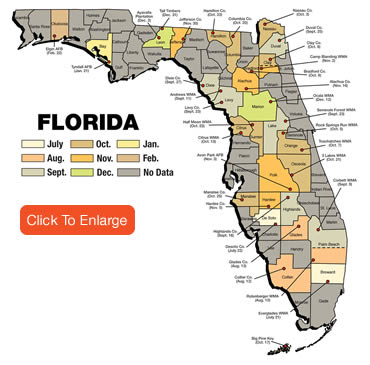 He also cautioned hunters to remember factors like warm weather can influence what you observe. “Warm weather does not change when deer breed,” he said, “it just makes them move more at night, which they already do for the most part.”
He also cautioned hunters to remember factors like warm weather can influence what you observe. “Warm weather does not change when deer breed,” he said, “it just makes them move more at night, which they already do for the most part.”
Florida’s Tony Young considers his state’s white-tailed deer rut to be “probably the most unique of all 50 states” because of its range. Does in the extreme southern portion of the peninsula come into heat as early as late July, while in the northwest and some areas of west-central Florida, the mean rut occurs as late as early to mid-February. “For the rest of the state, as you move farther north, and then west once you get past the peninsula, the rut comes in later and later, beginning in late July at the southern tip and continuing all the way until mid-February in the northwest part of Florida,” he said.
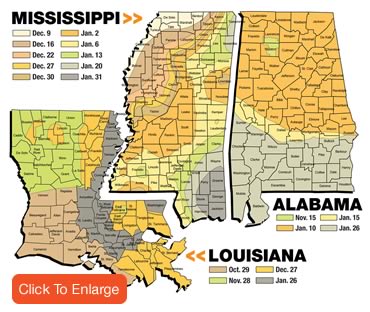 THE DEEP SOUTH
THE DEEP SOUTH
Georgia Deer Project Coordinator Charlie Killmaster said his state has an unusual range of peak breeding dates. He attributes this in part to a warm climate and deer restocking. Between mid-October and late January, the rut is peaking somewhere in Georgia.
Alabama Deer Studies Project Leader Chris Cook says peak breeding dates in Alabama are highly variable as well. “The majority of the state has peak breeding ranging from Christmas into the first week of February,” he says. “In general, deer in the northern half of the state will breed from Christmas until mid-January, while deer in the southern half typically breed from mid-January to the first week of February.” Sandwiched between these is the Black Belt region and its famed mid-January rut. “We also have some areas with late November breeding, and others with early to mid-December breeding,” he adds. Cook hopes to have a breeding chronology map of the state available in the next few years.
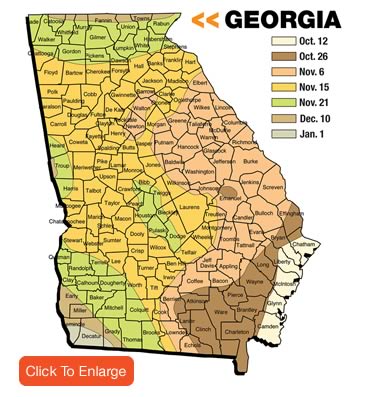 According to a map provided by Deer Program Coordinator Chad Dacus, peak rut in Mississippi becomes progressively later as you move across the state from northwest to southeast, beginning Dec. 6 through 13 in the northwest and wrapping up Jan. 24 through Feb. 6 in the southeast.
According to a map provided by Deer Program Coordinator Chad Dacus, peak rut in Mississippi becomes progressively later as you move across the state from northwest to southeast, beginning Dec. 6 through 13 in the northwest and wrapping up Jan. 24 through Feb. 6 in the southeast.
Louisiana Wildlife and Fisheries biologist Scott Durham said, “In Louisiana, deer breed from September to February, depending on the area, habitat and herd parameters.”
TEXAS
Texas has a range of peak dates that tend to roll counter-clockwise around the state. Our breakout map of the state shows the various regions and their rut peaks, as described in a recent stuty by the Texas Parks and Wildlife Department.
FINALLY
Peak whitetail conception above Latitude 45 is very consistent, offering strong support that photoperiodism is the key factor. This finely tuned system, evolved over eons, is critical to their survival. Deer in northern climates are born late enough to benefit from spring green-up, but early enough to achieve sufficient growth to survive the rigors of winter.
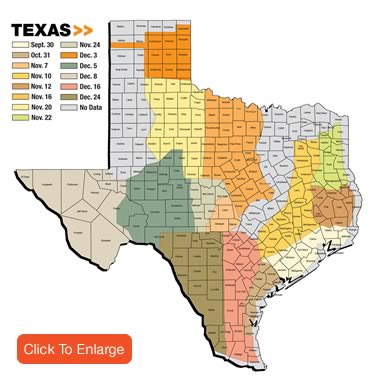 Moving south, winter survival becomes increasingly less of a factor. Habitat and rainfall become more important, and because they vary so much across the South, even within states, so does the rut. Additionally, many Southern populations contain genetic material of deer transplanted from northern states that creates a predisposition to breed in mid-November.
Moving south, winter survival becomes increasingly less of a factor. Habitat and rainfall become more important, and because they vary so much across the South, even within states, so does the rut. Additionally, many Southern populations contain genetic material of deer transplanted from northern states that creates a predisposition to breed in mid-November.
Peak breeding dates might vary, sometimes considerably from north to south and from one state to another and even within different regions or habitats in the same state. Regardless of where you are, peak rut dates don’t vary much, if at all, from one year to the next. Keep in mind these are peak dates, and breeding occurs earlier and later, the extent of which is influenced by factors including age and sex ratios, habitat and moisture.
This article was published in the August 2011 edition of Buckmasters Whitetail Magazine. Join today to have Buckmasters delivered to your home.